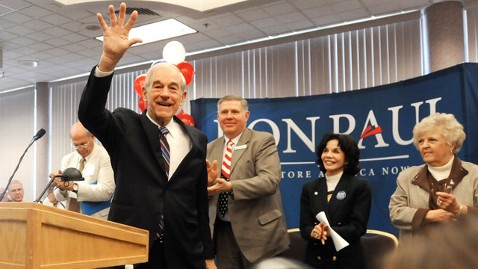2012, and how the GOP primary race has been shaped
The weekend has brought its partial results. With the vote from Puerto Rico in Sunday, Romney gets the delegates there.* Missouri held caucuses on Saturday, reportedly to a mix of amusement and anger, but results will not be announced until April. The New York Daily News reported Rick Santorum ahead. Ron Paul supporters, au contraire, are claiming that Paul won 48 of 53 delegates at stake.

Santorum at podium
Apparently the Show-Me State is not to be shown, at least not if the state GOP maintains its hold over procedure. By all accounts, Paul’s people and Romney’s people shared the field, both having spent serious time and effort organizing rather than on campaigning. What happens to Santorum’s earlier victory in the non-binding primary remains to be seen. (Paul said at the time that it was meaningless.)

Ron Paul
The weekend also brought some clarity in the national political press, now not claiming with one voice that the GOP primary race is between a ‘moderate’ and a ‘conservative’. More sensibly, GOP primary voters are defined according to a contest of greater population density versus less. As previously written, the GOP primaries have divided Romney-Santorum-Gingrich-Paul voters so far according to rural appeal versus metropolitan/suburban appeal. Santorum has taken most of the less populated counties, and he has taken states where rural and small-town counties and congressional districts outweigh metropolitan areas and suburbs. In this metric, as said, Santorum has been facing a divided field, because he has the left-overs all to himself. Romney, Gingrich and Paul have been dividing the more populated areas.

Illinois countryside
Up next: Illinois.
Illinois has its wide-open stretches, but former Pennsylvania governor Ed Rendell has pointed out that Santorum has a track record (this year) of almost winning the large industrial states—Ohio, Michigan. If Santorum maintains the same pattern in Illinois, Pennsylvania and Wisconsin, he will continue to pick up delegates but not states won. Tomorrow’s primary will show whether Romney has begun to cut into Santorum’s predictable success among the non-suburbanites in Illinois, whether Santorum is able to generate enough outrage is get out the Romney/Gingrich vote, whether Santorum can convey enough despair to convert more GOPers to Dems, etc.

A few of the Illinois suburbs
It is theoretically possible that Santorum might get about a third of Illinois’s 69 delegates. That gets a little harder to see, following this ruling by the U.S. District Court there last week, which helpfully allows more leverage than ever for some PACs. On March 13, the court ruled that two provisions of the Campaign Disclosure Act do not apply to PACs formed for the sole purpose of making independent contributions.
I like that word ‘independent’.
From the Illinois State Board of Elections:
“This ruling has no effect on any political committee other than one formed SOLELY for making independent expenditures.
Contribution limits are still in effect for Candidate Political Committees, Political Party Committees, and Political Action Committees which make coordinated expenditures or direct contributions to candidates or committees. The ruling allows an entity formed for the purpose of making independent expenditures ONLY, to create a Political Action Committee that is not bound by contribution limits. That Political Action Committee, which will be designated as an Independent-Expenditure-Only PAC, must still register with the SBE and must file all required disclosure documents when it reaches the $3000 filing threshold. It must report all receipts and expenditures and itemize those in excess of $150 on its quarterly reports. It must file a Schedule A-1 within 5 or 2 business days, (depending on when the contribution is received) whenever it receives a contribution of $1000 or more. It must also file a Schedule B-1 within 5 business days when it makes an aggregate of $1000 in independent expenditures within the 30 days prior to an election.”
This ruling allows an entity to have more than one Political Action Committee, provided the second committee is an Independent-Expenditure-Only PAC created only to make independent expenditures. Such committee may NOT make direct contributions or coordinated expenditures. The committee created to make independent expenditures only, is not subject to contribution limits; the Political Action Committee making direct contributions IS STILL subject to contribution limits. A Political Action Committee making direct contributions may also make independent expenditures without forming a second PAC, but it must still abide by the contribution limits.”
So if your political purpose, or strategy, is only to spend money on behalf of [whatever], you are free of two more modest limitations.
Not yet known how many candidates RomneyRomneyRomney have benefited from PACs formed since this ruling, which happens to come just one week before the Illinois primary.
Onward
Up March 24: Louisiana.
The Louisiana primary will be interesting. We’ll see Saturday whether Romney, Gingrich and Paul have made enough inroads around New Orleans, Baton Rouge, Bossier City, etc., to offset Santorum’s advantage in the places where newspapers don’t get. Santorum’s policies would be devastating to small towns, rural areas and the Gulf Coast in general. But Santorum–whose lobbying clients have not spared those regions—is on the campaign trail blaming everything bad on lack of development, euphemized as ‘jobs’, and on President Obama. It’s dismal to see, but it works, especially in combination with the factor of race.
My next post on Louisiana will be from there.
*Run-down of the remaining contests by metro-versus-rural metric, re-posted
- Missouri March 17 Santorum, 52 delegates
- Puerto Rico March 18 Romney, 23 delegates Winner-take-all statewide
- Illinois March 20 Romney, 69 delegates
- Louisiana March 24 Close three-way race, one of Santorum’s better hopes, 46 delegates Proportional
- DC April 3 Romney, 19 delegates Winner-take-all statewide
- Maryland April 3 Romney, 37 delegates Winner-take-all combined
- Wisconsin April 3 Maybe Santorum, 42 delegates Winner-take-all combined
- Connecticut April 24 Romney, 28 delegates Winner-take-all at 50%+
- Delaware April 24 Romney, 17 delegates Winner-take-all statewide
- New York April 24 Romney, 95 delegates Winner-take-all at 50%+
- Pennsylvania April 24 Romney, 72 delegates
- Rhode Island April 24 Romney, 19 delegates Proportional
- Indiana May 8 Santorum, 46 delegates Winner-take-all combined
- North Carolina May 8 Close three-way, something for Santorum, 55 delegates Proportional
- West Virginia May 8 Santorum, 31 delegates Proportional
- Nebraska May 15 Santorum, 35 delegates
- Oregon May 15 Maybe Santorum, 28 delegates Proportional
- Arkansas May 22 Santorum, 36 delegates Proportional/mixed
- Kentucky May 22 Santorum, 45 delegates Proportional
- Texas May 29 Romney/Gingrich, 155 delegates Proportional
- California June 5 Romney, 172 delegates Winner-take-all combined
- Montana June 5 Maybe Santorum, 26 delegates
- New Jersey June 5 Romney, 50 delegates Winner-take-all statewide
- New Mexico June 5 Romney, 23 delegates Proportional
- South Dakota June 5 Maybe Santorum, 28 delegates Proportional
- Utah June 26 Romney, 40 delegates Winner-take-all statewide



